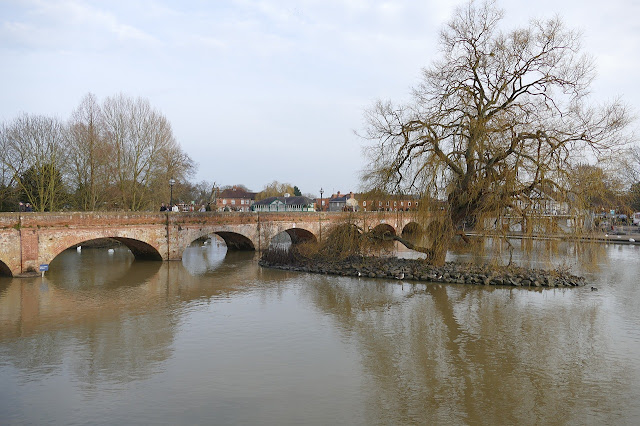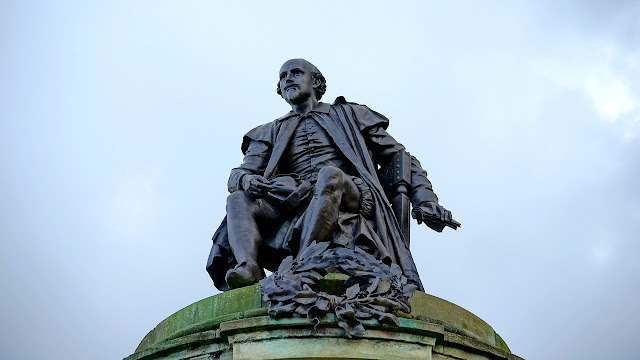“Throughout the play “Hamlet”, Shakespeare makes effective use of a variety of dramatic techniques to evoke a world full of deception and corruption.”
Discuss this statement, supporting your answer with reference to the play.
Elsinore is a place where everyone seems to be hiding behind something. On the surface, the Danish court is a world of nobility and dignity. In reality, it is a world of moral and political corruption, a world where the people and situation are rarely what they seem to be. The hypocrisy of the Danish court is perhaps what makes the play so compelling. I see a number of dramatic techniques used by Shakespeare to paint such a false and corrupted world in which Hamlet resides. Through the Ghost, soliloquies, imagery and juxtaposition the audience can see the truly rotten core of Elsinore.
You may also like: Complete H1 guide to Leaving Cert Higher Level English
 |
| Stratford-upon-Avon: Shakespeare’s birthplace |
The Ghost plays a hugely important role in the play as he is the first evidence that “something is rotten in the state of Denmark”. He effectively captures the audience from the beginning when he is classed as a “dreaded sight”. The Ghost of King Hamlet introduces the theme of corruption and deception. It shows deep disturbances in the kingdom, “bodes eruption to our state”, which shows the audience that this is not a regular occurrence in Elsinore. I believe the purpose of the tension between the Ghost and Hamlet is to show the mixed emotions held by Hamlet. He is grieving yet has a strong sense of uncertainty. “Angels and ministers defend us” shows how Shakespeare wants us to fear for Hamlet’s safety to heighten the dramatic tension. Hamlet’s dead father is the catalyst for change, and it is his dramatic revelations that get the play underway. The revelations about “the serpent that did sting thy father’s life” allow the audience to join the dots and understand that it is indeed Claudius who is the snake in question. Hamlet’s problem with his mother is confirmed when the Ghost speaks of “his shameful lust that will of my most seeming virtuous queen”, which gives the audience an opportunity form an opinion on Gertrude for who she truly is. However, the task of vengeance imposed on his son intensifies his suffering. Shakespeare proves how filial duty is of utmost importance to the young prince. He is fully aware of the corruption that infects the monarchy, he knows being loyal to his father is the only way to stop this vicious circle. The Ghost also forces the other characters to question Hamlets sanity. When he returns to “to whet thy blunted purpose” during the closet scene, Gertrude cannot see the Ghost of her husband past. She can only see her crazy and disturbed son. We are almost unsure what is and isn’t deceptive at this point. This phantom works as a narrative exposition, he sets the theme of deception and corruption from the moment he enters the play and gives Hamlet a sense of purpose.
You may also like: Full notes on “Hamlet”
The dramatic technique of soliloquies ensures the audience fully understand how corrupt and deceiving the kingdom of Elsinore really is. Shakespeare makes effective use of this technique to ensure the audience understand the inner turmoil Hamlet is going through and sympathise with the main character. During his first soliloquy, he sees the world as “weary, stale, flat, and unprofitable”. Shakespeare uses many exclamation marks to signify Hamlet’s distress. The Danish prince is clearly dealing with self-hatred as he classes himself as a “rogue and peasant slave”. The most famous of all soliloquies shows how Hamlet is in a suicidal state of mind. He considers the afterlife as an “undiscovered country from whose bourn no traveller returns”. However, this is dramatic irony due to the fact the Ghost returned. Shakespeare gives us an insight into Hamlet’s mind set as he wants us to comprehend the tragic effect this fraudulent state is having on the young prince. The corruption has significantly destroyed his sane thinking. It forces us to see Hamlet’s strong moral judgement in a world where nobody seems to value it. His strong frustration with his mother is carried through all of the soliloquies. The phrase “Frailty thy name is woman” is also foreshadowing for the nunnery scene. Soliloquies ironically grant us with the information of Hamlet’s plans of deceiving other characters. First of all, he reveals to us that “the play’s the thing”, where he will “catch the conscience of the king”. This also shows how soliloquies are a device used to move the play forward. Shakespeare reinforces the theme of deception during Claudius’ soliloquy. Hamlet is fooled into thinking that his “kindless” uncle is deep in prayer. The opposite is true: the prayer scene reveals a different side to the “remorseless, treacherous, lecherous, kindless villain”. Shakespeare makes use of soliloquies, so that the audience know more about the characters then the other characters do. This effectively adds a dimension of deception as well as corruption to the play.
Imagery is effectively used throughout “Hamlet” which provides us with a more in depth understanding of the deception and corruption in the Danish court. Weed imagery represents neglect, devastation and disorder. We learn that it is an “unweeded garden that grows to seed thing rank and gross in nature”. This gives us the image that the corruption is an eternal cycle that has grown from something just as complex and will continue to grow more unethical produce. Gertrude and Claudius’ relationship is also described in this way: “do not spread the compost on the weeds to make them ranker”. This makes us realise how toxic their love is. If it continues, it will only lead to a more immoral and politically corrupt state. Shakespeare also hints that the Danish political body is suffering from a metaphorical disease – and Claudius is the source of the moral infection. Hamlet refers to Claudius as the “canker of our nature”. The word canker can be described as the spreading of corruption or decay. This most certainly fits a description of Claudius, in my opinion. Yet, Claudius sees Hamlet and the State as a burden to him and compares himself to “the owner of a foul disease”. This again is ironic as he himself is the source of rotten disease. The queen, on the other hand, uses disease imagery when admitting to her sins by declaring a “sick soul”. Personally, I think the strongest use of this type of imagery is during Laertes’ grieving process. He claims “the sickness of my heart”. I believe Shakespeare makes effective use of disease imagery to show the audience that the corruption spreads through the State similar to how an infection would. “Hamlet” was first performed short after the plague had spread through London which may have inspired the use of olfactory imagery. The use of the word “foul” over and over again reinforces the stench of corruption that’s emanates from Claudius. Hamlet’s “I doubt some foul play” allows us to understand the complexity of his mind by expressing in it olfactory terms. Shakespeare effectively draws heavily on imagery and symbolism in order to deepen the audience’s understanding of the theme and characters.
Finally, the use of juxtaposition provides an effective insight into the corrupt and deceiving world that is Elsinore. First of all, it gives us information about the deceiving characters. Laertes and Polonius discuss Ophelia’s relationship with Hamlet. Laertes is very brotherly and makes her aware that he “cannot carve himself…for on his choice rests the health of Denmark”. This is gentle but realistic advice. Her father, however, is rude and condescending about their relationship but ironically needs Ophelia to talk to him to discover if he is “mad in craft”. The contrast between their advice and actions shows exactly how deceiving Polonius is. Shakespeare uses foreshadowing to intensify the theme of corruption. Laertes’ grief is used against him at the end of Act 4. He is manipulated by Claudius and agrees to murder Hamlet. Act 5, Scene 1 lets us meet the grave diggers who provide dark comedy and light relief to contrast with the tragedy and add to the dramatic tension of the play. The grave diggers foreshadow the corruption to the State. It cleverly foreshadows the morbid scenes ahead which include “the present death of Hamlet”. It reinforces the characterisation of Hamlet. In Act 3 Scene 4 he believes that “conscience does make cowards of us all”, which is followed by the Ghost’s return in Scene 4 to “whet thy blunted purpose”. This shows that Hamlet is thinking “precisely on the matter”, but that the only way to end such a tragic cycle is by fulfilling his promise to his phantom father. The juxtaposition in the play effectively lets the audience clearly see the world of deception and corruption evoked by Shakespeare.
To conclude, the world of deception and corruption evoked by Shakespeare is effectively brought to life through the use of the Ghost, soliloquies, imagery and juxtaposition. These techniques bring this world to life for the audience and help them to deeply understand the themes and characters of the play. The play would be much less compelling and would lack depth. I personally think that the master piece that is Hamlet is thought provoking because of all of the hidden techniques Shakespeare effectively used to evoke the world of deception and corruption.
You may also like: List of essential quotations for “Hamlet”
Based on an essay by Rachael O’Riordan
It’s quite a tough essay title! What makes this essay so good is the crystal clear structure. Rachael came up with four main points that clearly address the question (the Ghost, soliloquies, imagery and juxtaposition).
- She outlined the four points in the introduction.
- The body of the essay is made up of four paragraphs each of which clearly begins by addressing one of the four points.
- The four main points are echoed once again in the conclusion.
Clarity is key!

